First Flight:
Buzz Glade
![]()
First Flight:
|
|
by Alfred Scott
This article appeared in the December 1986 Falco Builders Letter. |
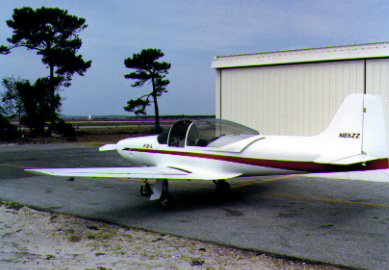
On November 1, the eleventh homebuilt Falco flew. Built by Buzz Glade of Jacksonville, Florida, it is by several measures a most remarkable Falco. Tony Bingelis saw it and reports, "The wing was slick as molded glass. I was going to go home and burn mine." Tony calls it the "best finished Falco" he has seen. "Outside it is gorgeous, just like glass."
Aha! But what does it weigh? Would you believe 1,065 lbs? Apparently even Buzz wasn't sure since he has weighed the plane twice.
The Falco has a 150 hp 0-320-A2C engine with a fixed pitch wooden prop, a Prince "almost-constant-speed" scimitar-bladed prop with curled-over tips. Hartzell calls them Q-tips, but on this prop they're called P-tips-same thing. At 68"/74" the prop has too much pitch, and Buzz can only get 2,000 RPM at full power on the ground. In the air, full power gets him 2,400 RPM and 165 knots indicated. (The production Falcos used two wood Hoffman props, the cruise HO-23-175-178 and climb HO-23-175-170-for 175cm diameter and 178 or 170cm pitch.) The Falco stalls at 50 knots dirty and 63 knots clean.
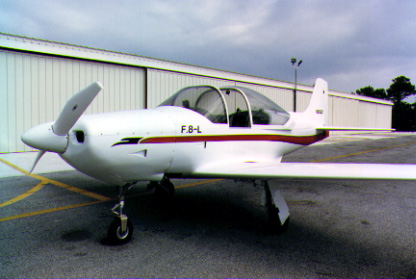
Buzz had not flown much in the seven years he took to build the Falco, so he had an instructor do the first flight. After the airplane flew, Buzz rushed out, got his biennial flight review and flew the Falco. It has also been flown by Carl Pascorell, who flies an SF.260 in the Redhawks aerobatic team. Carl reported that it flies "just like the Marchetti, only lighter and better."
The Falco, N85ZZ, is painted in a bright white, with a dark red and metallic stripes down the side. The interior is painted and no upholstery is planned. I was curious about the noise level, and Buzz said that it is surprisingly quiet.
I asked Buzz about the finish on the plane. He used the West System with no fabric. When the wood was ready to finish, he went over the plywood with a wet sponge to raise the grain and to close up the staple holes. After a day or so, he put on the first coat of West System epoxy with a roller. Previously he had found that-apparently because of high humidity-the epoxy would sometimes be gummy and difficult to sand. He called Gougeon Brothers, and they suggested using a heat gun right after application. Buzz said he worked with a roller in one hand and a heat gun in the other. Apparently just an initial heating to start the reaction was all it took, and he had good results whenever he used the heat gun.
When the first coat of West System was dry, Buzz sanded the airplane and then applied a second layer and sanded that. He then used microballoons-"dry micro"-right on the epoxy wherever there was a low spot. He said the micro sanded easily, but he always used the heat gun when he first applied it. When the sanding was complete, he touched up any spots where the epoxy might have been sanded too thin, and then sprayed a coat of Dupont Korlar primer. He filled in any pinholes with acrylic spotting putty and then sprayed two coats of Dupont Centari enamel. The first coat was a "tack" coat, and it was followed with a final spray. He used a gloss additive in the Centari on the airframe but shot straight, unblended Centari on the fabric-covered control surfaces.
Buzz said he did exactly the same thing to the wing and the fuselage. On the wing, you can't see any ripples at the ribs, but on the fuselage you can see the fuselage frames if you catch the light just right. Buzz has no idea why that's so. At this time, he says the plane is not much to look at since the cowling is not painted, nor is the canopy trim. He has a Lexan windshield-the third or fourth one he's had on the plane. He found that paint thinners do not agree with the Lexan.
At 1,065 lbs, Buzz Glade's Falco is the lightest yet. Buzz followed the plans and did not change any of the structure. Wherever possible, he shaved a few ounces off; for example, the battery access door does not have a piano hinge-it is installed with screws only. Buzz calls the Falco a "deluxe day VFR" machine. There is only a single, tiny 720 channel glider com radio.
(Don't laugh, the "French Connection" CAP-10 aerobatic team appears at about 40 air shows a year and has never missed an appearance in ten years because of weather. They don't have any nav radios, either. They navigate with sectionals and Texaco road maps and bring a new meaning to "low level scud-running.")
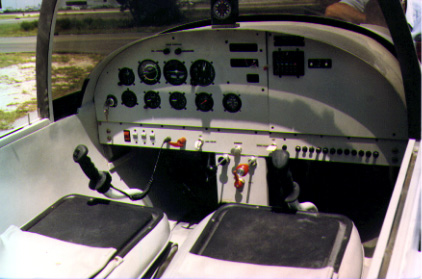
The instrument panel has a single electric turn coordinator, a vertical card compass, but there are no vacuum gyros. There is a basic electrical system with a 35 amp Japanese alternator and Gell/Cell battery. The gear and flaps are electric, but there are no navigation or strobe lights. Buzz installed the complete internal antenna system. The seats are upholstered, but the rest of the interior received a single coat of West System epoxy and one coat of paint.
The wooden propeller saves a lot of weight, but it also guarantees lethargic takeoff performance. The prop probably weighs about 15 lbs, and you also save the weight of the governor and prop controls. There is a mechanical and electric fuel pump, but no vacuum system. The conical engine mount is lighter than the dynafocal mount. There is no air filter installed yet. Buzz made his own cowling and reports that it is rather flimsy when you pick up each part, but it stiffens up when installed on the airplane. The windshield is 1/8" Lexan. That's half the thickness of our windshield, and Buzz reports that the windshield has pushed in slightly in flight. I doubt the windshield would stand up in a test flight to design speed.
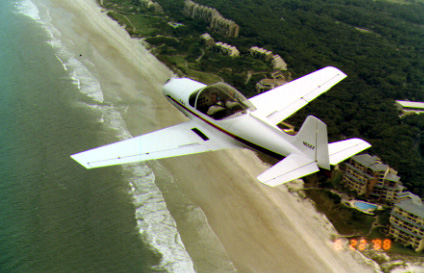
Buzz Glade flew C-130's in the Air Force. He has been around homebuilding for a long time and has helped with the contruction of various biplanes. Buzz and Susan Glade live in Jacksonville, Florida, where they operate a general contracting company. Buzz bought his plans in December 1979 and began work on the Falco shortly thereafter. Buzz made almost everything for the airplane, thus his Falco is a true plans-built Falco and took just under seven years of nights and weekends.
Buzz keeps the plane at the St. Augustine airport and had flown it only about 4 hours when I spoke to him. Because the propeller is not an approved installation, he must fly the airplane 40 hours before restrictions are lifted, and he plans to put in some hard flying to get the time flown off. Look for this Falco at Lakeland!
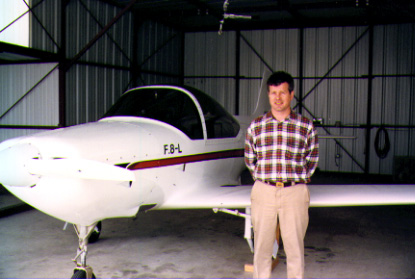
Buzz Glade